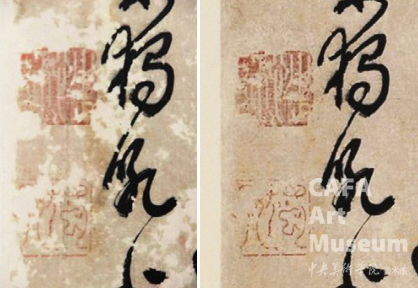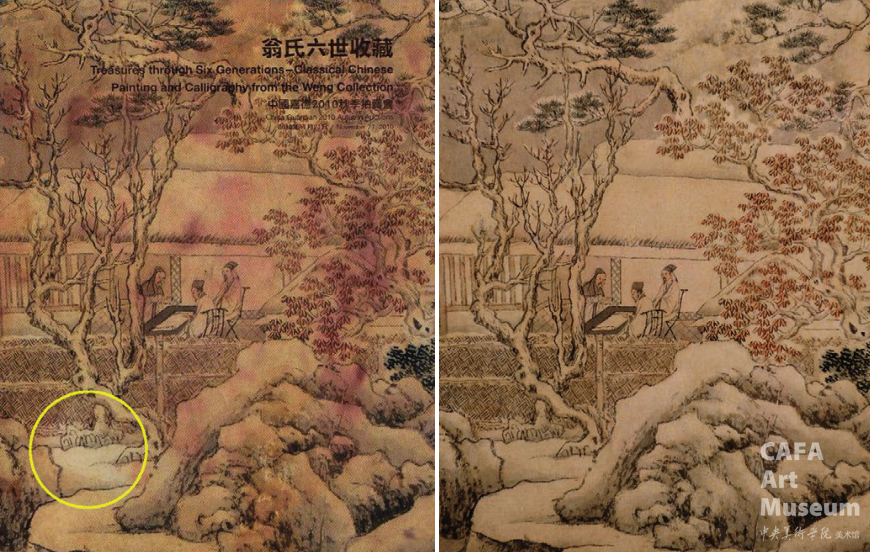
引言
修复的理念是修复工作者在实际工作中的指导思想,是开展科学保护修复工作的前提。中国书画修复与装裱的历史源远流长,然而在超过千年的历史中并没有形成完整的理论著作,长期以来祖祖辈辈都是师徒传授、手口相传,古人也只在书论、画论或者杂记中给我们留下不完整的零星资料。
西方则在很早的时期就出现了关于修复理论的探讨。20世纪60年代,意大利罗马中央修复研究所的学者、美学家切萨莱·布兰迪(Cesare Brandi)将西方之前的保护修复理念加以总结和整理,并结合自己的哲学、艺术知识以及实践经验,写出《修复理论》,在世界范围内产生了巨大的影响,至今被奉为西方艺术品修复的教科书式著作。中国自20世纪末起开始引进布兰迪的理论,然而,西方的保存修复理论是基于西方的特定历史文化背景和西方特有的艺术品而提出的,中国艺术品的特性及东方的文化、审美情趣与西方艺术品存在着固有的差异。此外,即使是布兰迪的理论在指导西方艺术品保护修复的具体实践时,也不可避免地存在矛盾。那么,在中国艺术品的文物保护与修复领域中,是否原封不动地直接引入西方的理念体系,是否按照西方的原则开展自身的工作,就是一个值得仔细探讨的问题了。
笔者从近四十余年的中国书画修复装裱的实践经验出发,在对西方修复理论进行吸取与反思的基础上,尝试通过对中国书画自身的艺术特点、修复的传统脉络和笔者平日实际工作中积累的经验进行分析研究,探寻一条适合中国书画作品的修复理论之路。
一、布兰迪的《修复理论》
凝聚了无数前人的智慧,又结合了艺术品修复发展现状,并以自身的哲学、历史、艺术底蕴为依托,《修复理论》一书自布兰迪完成之日起,就对现代艺术品修复领域产生了巨大的震撼,并被视为修复操作的教科书。布兰迪自身的经历与身处岗位赋予了他特有的优势,可以将理论与实际操作很好地结合起来,给现实工作以更好的指导。
在布兰迪看来,艺术品同时具有美学和历史学价值的“二元性”,也可以定义为“物质面和图像面”。他将修复行为定义为“是在思索艺术品传达给未来的含义时,在这个(艺术品的)物理性、实质性及审美性、历史性两极性中,形成了认识这个(艺术品的)方法论上的瞬间”。《修复理论》中提出的现代修复工作应当坚持的基本原则大概可以总结为三个方面:可逆性修复原则、可区分性原则与最小干预原则。
可逆性修复原则是指用于文物保护修复的材料需要具有可逆性。我们现在对文物的保护修复处理,都是建立于现有的科学技术水平的基础之上,以目前能做到的最大努力保证文物本体不受损伤,并延缓老化速率。但是随着科学技术的不断发展进步,必将会出现更为科学合理的保护方法或是保护材料。这就要求我们目前的处理手段,附加于文物之上的操作和材料都是可去除的,以便当技术成熟之时,可以为更合理的保护方案让出空间。
可识别性原则指附加于艺术品之上的保护修复材料和原有本体之间可以区分。这种区分既可以是能够通过肉眼直接观察到的,也可以是能够利用科学分析手段分辨的。差异性的存在可以保证后来的研究者不会受到保护修复材料的干扰,能够清楚分辨出原有艺术品的信息,获取正确的原始资料。此后,1964年召开的国际历史古迹建筑师及技师国际会议通过了《威尼斯宪章》,进一步对文物修复的范围做出了限制,要求文物修复时任何不可避免的添加都必须与该建筑的构成有所区别,并且必须要有现代的标记。当然这个修复原则主要是针对古建筑物而制定的。
最小干预原则指在能够保护艺术品的前提下,对本体施加的操作越少越好。这是为了尽量减少后来的操作对艺术品原有信息的覆盖和修改,最大限度保留原始资料信息。
《修复理论》一书为此前多只是通过实践操作摸索的修复师们提供了完整而系统的理论指导,同时,布兰迪深厚的哲学与历史积淀,以及颇具前瞻性的眼光,也为文物修复领域未来的发展指明了方向。虽然东西方文物类型、传承现状与审美观念尚有不小的差异,然殊途而同归,站在哲学与美学的思考高度上,布兰迪所提出的很多观点面对中国的文物修复领域同样具有很高的参考价值。
二、对布兰迪《修复理论》的反思
布兰迪《修复理论》中的理论与原则乃是书斋中理想状态下的理论描述,在实际操作的过程中,很多时候难以保证严格遵循这些理论而行。
如书中曾提到一幅圣母像的修复。修复前圣母像的头部残缺,修复者根据现有的.画意和以往宗教圣母绘画的图像经验重新补绘头部。理论上,此种将主观臆测的事物添加到本体上的行为并不符合最小干预原则的要求。然而,从实际操作的角度看,圣母像不同于其他艺术品,其宗教象征意义是创作之初的最重要的意图,若圣母像头部残缺,其宗教意义受损,失去了宗教偶像的地位,那么也就失去了其存在的价值,回归到旧的材料层面。因此,修复者需要作出调整和妥协,而不是完全按照理论中的规定进行操作。

【图1】日本版布兰迪《修复的理论》中插图,圣母像修复前后对比图
此外,《修复理论》中有关修复中清洗的讨论也不甚清晰。如书中一方面认为修复中需要保留时代变迁在艺术品上留下的“历史的遗痕”(“时代的烙印”),另一方面又提到绘画作品的修复首先要清洗,作品的潜在艺术价值才能被重新发掘出来。这两条原则相互矛盾:艺术品的所有附着物中,哪些是该被清除的遮盖物,哪些是需要保留的“时代的烙印”?二者该如何区分?而对于曾经修复过的艺术品,之前修理的附加物又该如何归类?是否应去除以恢复艺术品的“真实性”?尤其中国书画,在传承过程中被不断附加的痕迹更为明显,如后人的题跋、收藏印记等,这些显然不能单纯归为后来的附加物而直接去除。伴随着历史流传,书画作品会因受到污染与老化等关系,在其表面产生“古色”,古色见证了岁月的变迁,有其独有的艺术审美价值,故不能全部当作污渍完全去除,否则作品就会丧失其历史遗留痕迹,也就是我们通常所说的“古意”。

【图2】 董其昌册页,中国书画是题跋、鉴藏印和各种附加物的复合体
中西方艺术品特性和审美文化的差异注定我们无法将诞生于西方艺术土壤中的《修复理论》原封不动搬到中国的文化背景中,应当去芜存菁,在参考经验的基础上建立起属于自己文化独有的修复理念。
三、传统修复理念“修旧如旧”在实践中面临的困境
“修旧如旧”作为一种约定俗成的修复术语,在目前中国修复界传播与应用极为广泛。但是“修旧如旧”本身时间跨越大,在实际操作中很难准确地把握和实施。
“旧”是一个过去式,与“新”相对,时间跨度极大,从昨天甚至当下这一刻以前到数百上千年前艺术品诞生之时都可称为“旧”。那么当“旧”成为修复的指导标准时,到底要恢复到哪个时期的旧?是“原初的旧”(艺术品最初的原貌)还是“现在的旧”(经年变化后的面貌)?在修复工作中笼统地提倡“修旧如旧”,看似合理,然而落实到具体实际操作中,由于不同艺术品的特殊性及修复者对“旧”的不同理解、个人经验的差异,导致在同一个“修旧如旧”的观念下,出现了千差万别,甚至截然不同的修复结果。因此,“修旧如旧”无法成为新世纪修复实践中行之有效的指导原则。

【图3】 “修旧如旧”中“旧”在时间上跨越度很大
四、对中国书画现代修复理论的探讨
中国书画现代修复理念的建立,必须立足于中国书画特殊的文化属性与特点,在修复中用传统的哲学观点与审美取向来理解书画的物理性质和人文内涵,同时合理而有度地借鉴西方修复体系中的理论、科技手段、运行机制等。以下笔者就几个中国书画修复的理论及实践中的要点进行梳理和探讨。
1.从“修理”与“复原”谈起
修复工作往往包括两个层次的含义:一是修理,也就是修残、补缺、加固,停止损坏的进行,使作为作品载体的纸、绢、颜料等材料恢复机能,尽可能延缓劣化。二是复原,在修理与加固的基础上对艺术形象进行适当复原,挖掘出艺术品潜在的艺术价值——“现时点上的最美”,恢复其审美功能。
根据这两个层次与步骤,往往也将修复工作区分为两种修复类型:“维持现状修复”和“复原性修复”。前者主要从尊重文物传承的历史性出发,对现状采取宽容的态度;后者主要从艺术整体审美效果的恢复艺术价值的角度考量。二者各有侧重、各有其优弊。维持现状修理虽尊重了艺术品的真实性,但却容易导致修复行为的不作为或画面艺术性的缺失,此方法更适用于出土文物与古籍善本的修复;复原性修复为了理想中天衣无缝的效果,很可能过度介入甚至是不择手段,从而影响作品的长久保存,此方法多用于传世书画的修复中。由于艺术品是独一无二且多样性的,在修复过程中不应该用单一的修复方法对待所有的作品,应根据具体修复对象的实际情况,灵活地采取相适应的修复方法,并可将“维持现状修理”和“复原性修复”相互融合借鉴,既不过度介入,也不消极地不作为,这就需要一种介于两者之间的“部分复原”。针对不同的书画作品,三种修复方法并存,选择最适合的进行操作使用,才能满足多样化的修复目的。
2.“吾随物性”:“部分复原”的平衡
在具体修复作品时不能人为地给其设定一个修复标准,而是要“吾随物性”,即根据修复对象的需求,设计一个符合书画艺术品个性的修理方案,在兼顾物质特性、艺术审美和历史价值的统一基础上,对可复原的和不可复原的部分进行甄别处理,来实现画面在当下时点上最完整和谐的美。
要达到这一目的,落实在修复实践操作上便是前面所提出的“部分复原”。于是又涉及到书画修复中的另一个命题——“可为”“不可为”,即通过修复可以完整复原的作品,但由于个人修复水平及其他原因达不到较好效果的时候,就不要勉强为之;“能为”“不能为”,即对于技术所能达到的,但是却因过度追求修复效果,而使作品不能够长久保存的情况下,是“不能为”的。如图4的书法作品,文字部分缺损的是笔画的中间,前后都有线条在,可以对其推断和修复。但是印章由于是刀子与石头碰撞出来的,即使其他作品上有标准的完整印章,但用软的毛笔很难模仿出硬的金石气,况且各年代的印泥材质和颜色也不同,就不必勉强完美复原,只把底色补全,让作品看上去是完整的作品即可。

【图4】部分复原的书法作品(局部)
3.挖掘“现时点上的最美”——“古色”与“污色”
这个命题涉及到修复操作中关于洗画的标准与程度问题。一幅作品流传了几百年甚至上千年,当它在传世过程中自身不可逆转的材料老化,受到了空气中的灰尘,紫外线照射,或是其他诸如受潮、长霉、油渍污渍等污染后,慢慢地,画面变黄变旧,最后影响到观者欣赏画意,这时就需要对画面进行适当的清洗了。那么应该清洗到什么程度为好?
首先要分清什么是“古色”和“污色”,二者都是流传过程中产生的污染,然而“古色”是经年变化后天然的化妆,让作品有时代气息,画面看上去温润自然,是一种愉悦的审美感受。而污色则是那些干扰我们欣赏作品的因素,不但影响了作品的长久保存,画意也被掩盖住,削减了艺术审美价值。在清洗时需要“去污留旧”,既保留“旧”的时代感,又去掉破坏作品画意的“污”,辩证地看待二者是清洗环节的关键点。

【图5】 作品的经年变化示意图
在弄清了以上问题之后,就要谈一下清洗的“程度”问题。由于各历史时代都有不同的创作材料和风格,带给观者的审美感受就会有一个抽象的认知标准。一幅宋代创作的花鸟小品,变成咖啡色我们是能接受的,反而是把它洗成干干净净的“新”画,观者就会质疑其真实性了。这就像人在不同年龄阶段各有风韵一样,把百岁老人整容成小女孩儿必然会觉得不伦不类,但如果一位老者满头银发,干净整洁地端坐在面前,也不失是种优雅的美。

【图6】 水彩画清洗前后对比
同理,作品流传至当下时,如果保存妥当,只是自然老化而没有被严重污染和损坏的情况下,就是其最美的状态。这个标准点不是人为的想象,而是要在作品中寻找,也就是以画面中相对保存最好的地方为基准,周围都按照这个标准来进行清洗和修补。了解作品真正的内在诉求才能收到一个恰到好处的修复结果,有了相对量化的指导性理念也就避免了人为主观地定标准而造成的修复结果大相径庭的局面。弄清一些理论的误区,就能挽救更多珍贵文物。
五、中国书画修复理论的现代重建
中国传统书画修复装裱的操作早已自成体系,只要深入了解这个技术传统,仔细领悟,就可以体会到指导修复和装裱工作的理论是实际存在的,虽然它不是完美无瑕疵的系统,但就传世中国书画的保存质量与数量之多便足以证明,传统的修复与装裱方式对书画的保存和修护是行之有效的,也是符合科学规律的。对于西方修复理论与实践,我们不应该盲目地完全照搬与国际接轨,毕竟文化是根植于不同土壤里的产物,它没有优劣和高低之分,更没有先进和落后。西方的修复注重理性和科学的架构,越来越向学科性发展,这正是我们所欠缺的,也是要吸取的部分。加之固有的书画修复装裱技术,建立理论框架的同时,也需进一步研究和完善传统技艺,二者齐头并进,相辅相成。

【图7】翁同穌旧藏《匏庵雪咏图》遍布红霉的画面清洗前后对比图,黄圈内就是保存相对完好的当下最美的状态,清洗程度以此为标准点。
笔者认为修复的目的不是让艺术品回到过去,而是要让它再传五百年。那么就要把作为创作载体和显现体的纸、绢、颜料等的材料保护放在首要位置,这就需要科学的文物分析保护作为支撑,在修复过程中选用安全性高,可逆且不影响作品长久保存的材料和方法来进行修复。满足了这一条件的基础上,再对作品潜在的审美价值进行发掘,使作品的画意与历史遗痕能够完整地展现在观者面前,而这一切都要用高超的修复技术来实现,所以21世纪的修复应该是以科学保护为前提,以技术为核心,引入艺术审美,在三者之间寻求一个平衡点的综合性学科。它源自传统,面向未来,让艺术品更长远地传承。这一历史使命不是几个人能完成的,而是需要许多有知识素养、技术能力且热爱文化和文物的人一起来实现。我们要对中国传统艺术品的特性和保存与修复方法进行总结,“努力走出一条符合国情的文物保护利用之路”。
作者|陆宗润(中国艺术研究院硕士导师、工笔画研究院副院长、日本汉和堂金石书画修复研究所所长)
原文发表于《中国美术馆》2016年05期
编辑|郑丽君
